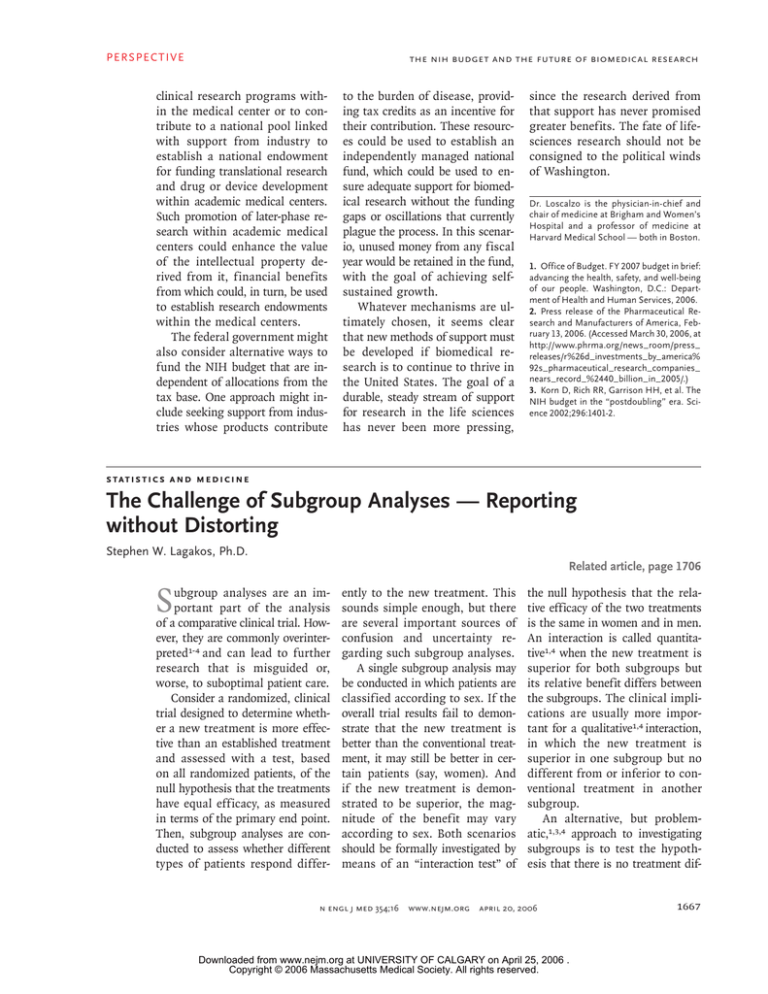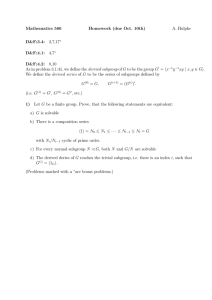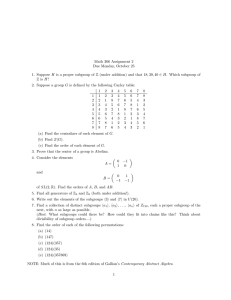
PE R S PE C TI V E
the nih budget and the future of biomedical research
clinical research programs within the medical center or to contribute to a national pool linked
with support from industry to
establish a national endowment
for funding translational research
and drug or device development
within academic medical centers.
Such promotion of later-phase research within academic medical
centers could enhance the value
of the intellectual property derived from it, financial benefits
from which could, in turn, be used
to establish research endowments
within the medical centers.
The federal government might
also consider alternative ways to
fund the NIH budget that are independent of allocations from the
tax base. One approach might include seeking support from industries whose products contribute
to the burden of disease, providing tax credits as an incentive for
their contribution. These resources could be used to establish an
independently managed national
fund, which could be used to ensure adequate support for biomedical research without the funding
gaps or oscillations that currently
plague the process. In this scenario, unused money from any fiscal
year would be retained in the fund,
with the goal of achieving selfsustained growth.
Whatever mechanisms are ultimately chosen, it seems clear
that new methods of support must
be developed if biomedical research is to continue to thrive in
the United States. The goal of a
durable, steady stream of support
for research in the life sciences
has never been more pressing,
since the research derived from
that support has never promised
greater benefits. The fate of lifesciences research should not be
consigned to the political winds
of Washington.
Dr. Loscalzo is the physician-in-chief and
chair of medicine at Brigham and Women’s
Hospital and a professor of medicine at
Harvard Medical School — both in Boston.
1. Office of Budget. FY 2007 budget in brief:
advancing the health, safety, and well-being
of our people. Washington, D.C.: Department of Health and Human Services, 2006.
2. Press release of the Pharmaceutical Research and Manufacturers of America, February 13, 2006. (Accessed March 30, 2006, at
http://www.phrma.org/news_room/press_
releases/r%26d_investments_by_america%
92s_pharmaceutical_research_companies_
nears_record_%2440_billion_in_2005/.)
3. Korn D, Rich RR, Garrison HH, et al. The
NIH budget in the “postdoubling” era. Science 2002;296:1401-2.
s tatis tic s and medicine
The Challenge of Subgroup Analyses — Reporting
without Distorting
Stephen W. Lagakos, Ph.D.
Related article, page 1706
S
ubgroup analyses are an important part of the analysis
of a comparative clinical trial. However, they are commonly overinterpreted1-4 and can lead to further
research that is misguided or,
worse, to suboptimal patient care.
Consider a randomized, clinical
trial designed to determine whether a new treatment is more effective than an established treatment
and assessed with a test, based
on all randomized patients, of the
null hypothesis that the treatments
have equal efficacy, as measured
in terms of the primary end point.
Then, subgroup analyses are conducted to assess whether different
types of patients respond differ-
ently to the new treatment. This
sounds simple enough, but there
are several important sources of
confusion and uncertainty regarding such subgroup analyses.
A single subgroup analysis may
be conducted in which patients are
classified according to sex. If the
overall trial results fail to demonstrate that the new treatment is
better than the conventional treatment, it may still be better in certain patients (say, women). And
if the new treatment is demonstrated to be superior, the magnitude of the benefit may vary
according to sex. Both scenarios
should be formally investigated by
means of an “interaction test” of
n engl j med 354;16
www.nejm.org
the null hypothesis that the relative efficacy of the two treatments
is the same in women and in men.
An interaction is called quantitative1,4 when the new treatment is
superior for both subgroups but
its relative benefit differs between
the subgroups. The clinical implications are usually more important for a qualitative1,4 interaction,
in which the new treatment is
superior in one subgroup but no
different from or inferior to conventional treatment in another
subgroup.
An alternative, but problematic,1,3,4 approach to investigating
subgroups is to test the hypothesis that there is no treatment dif-
april 20, 2006
Downloaded from www.nejm.org at UNIVERSITY OF CALGARY on April 25, 2006 .
Copyright © 2006 Massachusetts Medical Society. All rights reserved.
1667
PE R S PE C T IV E
the challenge of subgroup analyses — reporting without distorting
ference separately in women and
in men. However, even if both sexspecific treatment differences are
statistically significant, this approach does not address the question of whether the magnitude of
benefit depends on sex. Moreover,
subdividing the data into subgroups reduces the study’s power
to detect treatment differences,
because not only are the sample
sizes reduced, but the number of
statistical tests needed is also more
than double that required to test
for an interaction.
In practice, multiple subgroup
analyses are frequently performed.
For example, in this issue of the
Journal, Bhatt et al. (pages 1706–
1717) report having performed
20 prespecified analyses in subgroups defined according to different baseline variables. When
multiple interaction tests are conducted, each using a nominal criterion (say, P = 0.05) to assess statistical significance, the probability
of a false positive result — that
is, of appearing to find an interaction when none exists — can
be greatly inflated. For example,
when treatments have identical
efficacy, the probability of finding at least one “statistically significant” interaction test when
10 independent interaction tests
are undertaken is 40 percent (see
graph). The more subgroup analyses conducted, the higher the probability of one or more chance findings that may be misinterpreted
as clinically directive.
One way to correct for the inf lated false positive rate when
multiple subgroup analyses are
conducted is to apply a stricter
criterion than the usual P = 0.05
for judging the significance of
each interaction test.1,2 If K independent tests are conducted, one
way to ensure that the overall
chances of a false positive result
1668
are no greater than 5 percent (0.05)
is for each test to use a criterion
of (1–0.95)1/k, or about 0.05÷K, to
assess statistical significance. For
example, if 10 tests are conducted, each one should use 0.005 as
the threshold for significance.
False positive rates are also inflated when the multiple interaction tests are not independent of
one another; since corrections for
this problem require information
about the correlation among the
tests,2 the criteria for statistical
significance used for independent
tests are commonly applied, even
though these criteria may be conservative.
In the 20 subgroup analyses
conducted by Bhatt et al., only one
interaction test, for symptomatic
versus asymptomatic patients (see
the article for the precise definitions), gives an uncorrected P value smaller than 0.05 (0.045). Had
the interaction tests been assessed
with a criterion of 0.05÷20 (0.0025)
to account for the fact that 20
were conducted, none would have
come close to reaching statistical significance.
Instead of assessing an uncorrected P value against a stricter
criterion for significance to account for multiple subgroup analyses, one can sometimes correct
the P value so that it can be compared with the usual criterion of
P = 0.05. When K independent interaction tests are performed, the
appropriate correction for the
smallest of the resulting P values
— say, P* — is 1–(1–P*)k. This
formula can be modified for correlated tests, and if applied without modification, it will usually
be conservative. Its application to
the analyses by Bhatt et al. gives
a corrected P value of 0.60 for the
interaction test of whether the relative efficacy of clopidogrel depends on symptomatic status.
n engl j med 354;16
www.nejm.org
The inflation of false positive
rates by the application of multiple statistical tests applies to
both prespecified and post hoc
subgroup analyses. The important
distinction is that the number of
prespecified subgroup analyses
is known and determined before
the data are examined (though in
some cases, important details such
as how variables such as age will
be categorized are not specified
in advance). In contrast, when a
report presents the results of post
hoc subgroup analyses, it may be
unclear why and how the subgroups were selected and how
many other subgroups were analyzed. Post hoc subgroup analyses
undertaken because of an intriguing trend seen in the results or
selective reporting of certain subgroup analyses can be especially
misleading.1
Authors and medical journals
have a responsibility to ensure that
the reporting of subgroup analyses is transparent. Ignorance of the
total number of subgroup analyses, which ones were prespecified
and which were post hoc, and
whether any were suggested by
the data makes it very difficult
to interpret the reported results.
When an interaction test for a
baseline variable fails to reach the
appropriate threshold for significance, conclusions about a differential treatment benefit related
to this variable should be avoided or presented with caution.
When subgroup analyses are
properly conducted, presentation
of their results can be informative,
especially when the treatments being compared are used in practice. When reporting subgroup
analyses, it is best not to present
P values for within-subgroup comparisons, but rather to give an estimate of the magnitude of the
treatment difference and a cor-
april 20, 2006
Downloaded from www.nejm.org at UNIVERSITY OF CALGARY on April 25, 2006 .
Copyright © 2006 Massachusetts Medical Society. All rights reserved.
PE R S PE C TI V E
the challenge of subgroup analyses — reporting without distorting
1.0
≥ 1 False positives
0.9
0.8
Probability
0.7
≥ 2 False positives
0.6
0.5
0.4
≥ 3 False positives
0.3
0.2
0.1
0.0
0
2
4
6
8 10 12 14 16 18 20 22 24 26 28 30 32 34 36 38 40
timal clinical practice. Yet avoiding
any presentation of subgroup
analyses because of their history
of being overinterpreted is a steep
price to pay for a problem that can
be remedied by more responsible
analysis and reporting. Ultimately,
medical research and patients are
best served when subgroup analyses are well planned and appropriately analyzed and when conclusions and recommendations about
clinical practice are guided by the
strength of the evidence.
Dr. Lagakos is a professor of biostatistics at
the Harvard School of Public Health, Boston,
and a statistical consultant to the Journal.
No. of Subgroups Tested
Probability That Multiple Subgroup Analyses Will Yield at Least One (Red), Two
(Blue), or Three (Yellow) False Positive Results.
responding confidence interval.
This information can be presented
concisely in a figure, along with
other summary information, as
illustrated by Antman et al. in a
recent issue of the Journal.5 These
confidence intervals should not
be used to infer whether a treatment difference in a subgroup is
statistically significant, on the
basis of whether the interval ex-
cludes the hypothesis of equality
between treatment groups, since
such analyses suffer from the same
problems as the use of multiple
statistical tests. Rather, they should
be interpreted as providing a plausible range of treatment differences
consistent with the trial results.
Overstating the results of subgroup analyses can misinform future research and lead to subop-
n engl j med 354;16
www.nejm.org
1. Yusuf S, Wittes J, Probstfield J, Tyroler
HA. Analysis and interpretation of treatment
effects in subgroups of patients in randomized clinical trials. JAMA 1991;266:93-8.
2. Bailar JC III, Mosteller F, eds. Medical
uses of statistics. 2nd ed. Waltham, Mass.:
NEJM Books, 1992.
3. Assmann SF, Pocock SJ, Enos LE, Kasten
LE. Subgroup analysis and other (mis)uses
of baseline data in clinical trials. Lancet
2000;355:1064-9.
4. Parker AB, Naylor CD. Subgroups, treatment effects, and baseline risks: some lessons from major cardiovascular trials. Am
Heart J 2000;139:952-61.
5. Antman EM, Morrow DA, McCabe CH, et
al. Enoxaparin versus unfractionated heparin
with fibrinolysis for ST-elevation myocardial
infarction. N Engl J Med 2006;354:1477-88.
april 20, 2006
Downloaded from www.nejm.org at UNIVERSITY OF CALGARY on April 25, 2006 .
Copyright © 2006 Massachusetts Medical Society. All rights reserved.
1669




